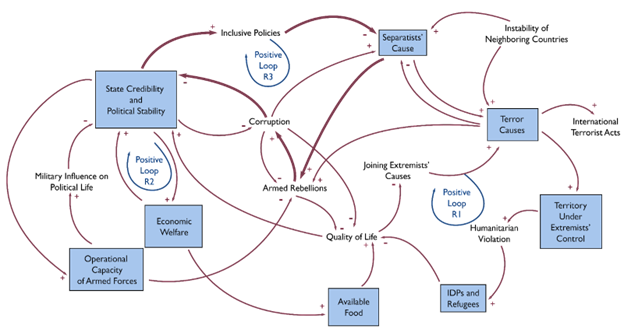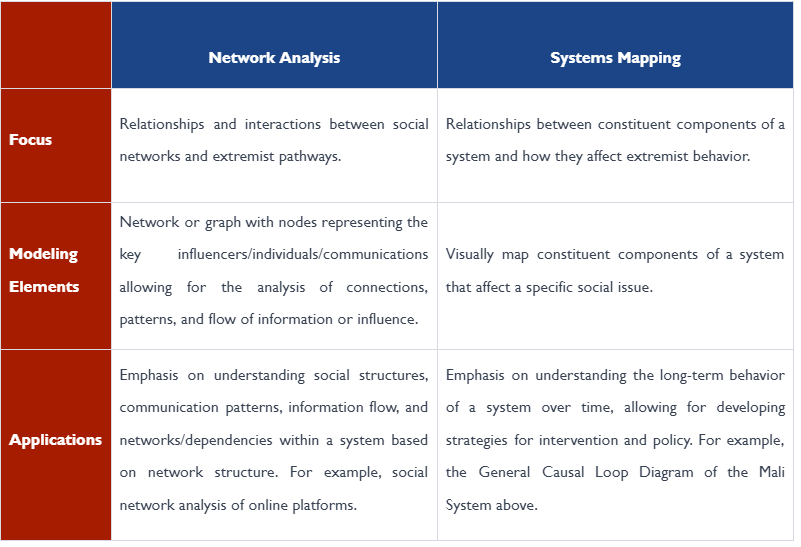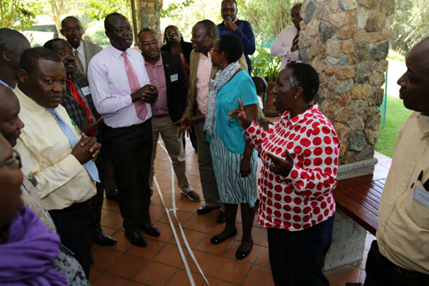|
Countering Violent Extremism is essential to promoting peace and furthering development objectives. However, the challenges posed by violent extremism (CVE) have evolved, and the ability of violent extremist organizations (VEOs) to do harm has increased, forcing us to re-evaluate how we work. Practitioners working in CVE have shown that strengthening and influencing local institutions and communities systemically is more effective in reducing radicalization and violent extremism than programming aimed solely at, for instance, unemployment, illiteracy, or other individual drivers. Decades of learning from past research and programming has informed USAID’s Policy for Countering Violent Extremism Through Development Assistance and our overall understanding about how, when, and why violent extremism manifests itself and the ways in which development assistance can have the greatest impact. Because violent extremism is spread through relationships and systems of social connection, it is best countered systematically.
This edition of the DRG Learning Digest examines the following topics:
- What is a Systems Approach to CVE?
- Systems Mapping to Identify Points of Entry and Influence
- Network Analysis Helps Detect Changes Over Time
- From Systems Thinking to Systems Strengthening
Please make use of DRG Evidence and Learning Team resources! (See text box at the end.)
What is a Systems Approach to Countering Violent Extremism?
Violent extremism is a highly social endeavor. While there is no single pathway to recruitment or radicalization, one factor outweighs all others: social connection. Relationships can be key determinants of violence: individuals with close ties to potential recruits or perpetrators have an outsized role in advocating for, or interrupting violence. Women, in particular, play active roles as recruiters, sympathizers, perpetrators, and combatants in conflict, or as negotiators, peacebuilders, and leaders in preventing and managing conflict.
VE, like conflict, is shaped by an interconnected set of factors that interact in dynamic ways. Effectively reducing the risk of recruitment and radicalization to violence requires an evolving understanding of complex systems that influence both positive social behaviors and violent behaviors. Consequently, CVE practitioners have adopted numerous methodologies to better analyze the systems within which they operate. For example, systems mapping, which identifies relationships, patterns, cycles, feedback loops, and leverage points within a system, has long been used to model relationships among terrorist, criminal and other non-state organizations to support counterterrorism efforts. Network analysis, where people, groups, and organizations and the relationships between them are identified, can also be a powerful tool in prevention.
 Messages of peace outside a youth-focused community center of one of USAID’s flagship CVE programs, which has worked with more than 30,000 marginalized and vulnerable youth. Photo: Kyle Beaulieu
Systems Mapping to Identify Points of Entry and Influence
Causal Loop Diagrams are a type of systems mapping that can be used to understand the behavior of complex systems over time. Causal Loop Diagrams help analysts chart causality by creating feedback loops to show how drivers of conflict or violent extremism exacerbate or mitigate one another. These models identify leverage points, where small interventions affecting one or more elements can have large effects on the system as a whole. Using this approach, analysts can also consider time delays, where the full effects of relationships can take time to materialize and may produce different effects in the short and long term.
Systems mapping is not necessarily meant to be a rigorous empirical process; the primary benefit of the modeling emerges from the process of its development. For example, researchers investigating the political crisis in Mali used a Causal Loop Diagram to map the country’s conflict system (Figure 1). Overall the figure depicts the role generic variables such as economic conditions, the capacity of VEOs and security forces, and the drivers of VE played within Mali’s political crisis. Specific relationships highlight how dynamics interact and hint to entry points for programming. For example, positive feedback loop R3 (in blue) shows how corruption abets the separatists’ cause and feeds rebellion. In addition to enhancing state credibility, anticorruption programming could have a strong impact on reducing drivers. Similarly, positive feedback loop R1 suggests that higher quality of life decreases the ability of VEOs to recruit, which will result in less area under their control. Less area under the extremists’ control will result in fewer refugees, which increases the overall quality of life.
 Figure 1: General Causal Loop Diagram of the Mali System, from “A Systems Thinking Archetype to Understand, Analyze, and Evaluate the Evolution of International Political Crises.” Pluses and minuses indicate positive and negative relationships, respectively.
Network Analysis Helps Detect Changes Over Time
Similarly, network analysis enables analysts to identify 1) influential actors, groups, and subgroups, 2) the number and diversity of actors, 3) the flow of resources and information in their system, and 4) communication networks between violent extremist organizations (VEOs), their members, potential recruits, and their communities. Given the fluidity of group membership in places like West Africa where different violent extremist organizations vie for recruits, network analysis can unveil the relative strength of different groups and their communal ties. For partners grappling with racially and ethnically motivated violent extremism (REMVE), network analysis offers insights into the recruitment and radicalization process that would not be visible with an organization or actor-based analysis, given the diffuse nature of the threat.
Network analysis offers a window into the context that systems mapping methods may not. For example, a network analysis in regions of Somalia helped researchers to identify power and identity as key factors in the radicalization process, the communication channels used by Al-Shabaab in its messaging dissemination, and highly complex patterns of communal trust. Knowledge of the factors driving radicalization, where individuals receive information, and who they trust to deliver that information were essential for CVE efforts that followed. Additionally, utilizing an intersectional gender lens in the analysis can provide insights into how to improve countering violent extremism program design, implementation, and evaluation, because it helps us identify the multidimensional nature of gender and the ways in which it impacts security and the expectations of how people engage within their system. This insight enables practitioners to design more effective CVE programs and policy.
Network Analysis and Systems Mapping are not mutually exclusive approaches, and sometimes a combination of both may be used for understanding the complex dynamics to enable more effective CVE programs. Network analysis can help identify key stakeholders and communication/information sharing patterns, while systems mapping can provide insights on the evolution of extremist patterns over time. The choice between network analysis and systems mapping depends on the specific goals of the program and nature of the system within the context, but they have distinct characteristics and applications (outlined in the table below).

From Systems Thinking to Systems Strengthening
CVE interventions that target individual level drivers, but do not alter the system in which the individuals operate, will fail to produce sustained results at the individual or collective level. Systems thinking opens the door to better programming. USAID’s experience demonstrates that CVE programs that strengthen local relationships between communities, security forces, and governments; build early warning and detection capacity; and support the development of local CVE action plans are far more likely to alter the systems that drive and sustain radicalization and VE recruitment. In the Republic of Niger, for example, USAID’s Office of Transition Initiatives (OTI) worked with 12 civil-society leaders in the Southern Diffa region to create the Nalewa Mada network to enhance the resilience of local leaders to Boko Haram (BH) and Islamic State-West Africa (ISIS-WA); today, the network includes more than 300 religious, traditional, youth, and women leadership in 30 villages. Although conflict continues to affect the region, communities and local authorities recognize the network as a key contributor to efforts to promote peace and reconciliation.
USAID’s Violence and Conflict Assessment (VCA) Framework provides additional guidance for development practitioners seeking to implement a systems lens into their CVE interventions. VCAs identify the systems that facilitate or diminish armed conflict and violence and provide USAID with actionable recommendations to integrate into program design and implementation that effectively prevents, manages, or mitigates violent conflict. Its structured analytical approach allows users to incorporate systems mapping, network maps, and other systems thinking tools into the analysis. Using the VCA to identify leverage points within the system can direct practitioners to programmatic approaches most appropriate for their context. For example, community policing activities that support the prioritization and facilitation of partnerships between police officers and communities may be appropriate where a VCA identifies that trust deficits between security forces and local communities are a significant contributor to VE and VEO recruitment. Where local partners are committed to CVE but lack capacity, missions can work with governments to develop national or local action plans for CVE and improve implementation by developing and strengthening relationships between government and civil society. Assisting governments to revise curricula and strengthening the government's monitoring capacity of intolerance in classroom content may be appropriate where a VCA links education to radicalization and VEO recruitment.
 |
Government of Kenya officials participate in a NIWETU-supported MOI CVE training. Photo: Hank Nelson/NIWETU
USAID’s Kenya NiWajibu Wetu (NIWETU) activity in Kenya applied a systems lens at the local level to build CVE capacity for sustained results. Using network analysis to map stakeholders, the team determined perceptions of VE risk and interest and capacity to contribute to CVE activities. Building on the knowledge they gained, implementers targeted leverage points in the system by supporting 41 counties across Kenya to develop inclusive, locally informed CVE County Action Plans, developed a deliberate gender strategy that sought to prioritize and integrate gender-based design throughout interventions, developed a CVE Facilitation Guide used to train 63 local facilitators who went on to train over 1,200 community members, and actively shared lessons learned with Kenya’s National Counter Terrorism Center. The evaluation was the culmination of a longitudinal study of NIWETU interventions over the span of four years from 2016 to 2020, and one outcome was a notable improvement in the government’s response to VEO attacks. Additionally, improved relationships between local and national governments were instrumental in reducing the number of indiscriminate arrests following the 2019 Al-Shabaab attack on the 14 Riverside Drive Complex in Nairobi and for sparking more coherent community interventions in other VE hotspots.
Further Assistance
The Center for Conflict and Violence Prevention within USAID’s Bureau for Conflict Prevention and Stabilization (CPS/CVP) is available to support USAID Missions to integrate systems thinking and mapping through technical assistance, including through a Violence and Conflict Assessment. Please submit a UTRAMS request or contact CVP’s Analysis and Evidence Team at analysisevidenceteam@usaid.gov.
In addition, CPS/CVP partners with the United States Institute of Peace (USIP) to develop a new publicly-available online course in systems thinking for conflict prevention and peace.
The free, self-paced System Thinking course takes 5-8 hours to complete and can help USAID staff apply a systems lens to conflict and violence challenges. The course is available on USIP’s Gandhi-King Global Academy.
DRG Learning Events
December DRG Cadre Learning Event – On Tuesday December 19th and Thursday December 21st USAID’s DRG Cadre Conversation focused on Countering Violent Extremism. The session was an opportunity to learn about new research from the Africa Bureau, explore the impact of the Israel-Hamas war on different Missions globally, and hear updates from the Bureau for Conflict Prevention and Stabilization on CVE.
Tuesday Group: Why Demography Matters for DRG – Understanding social and political demographic research is critical to the work of the Democracy, Human Rights, and Governance Bureau. On January 23, USAID Jefferson Fellow, Dr. Loretta Bass, highlighted key findings about demographic transition and the interrelated changes in mortality, population growth, fertility, migration, and the population age structure and how it relates to democratization, human rights, and governance from a demographer's lens. Namely, her findings concluded three main takeaways: 1) Demography is the jet stream of development – either a headwind or tailwind – for all development efforts; 2) Age structure and the demographic dividend affect development and democratic processes; 3) Demographic factors are interconnected and lead to virtuous cycles.
Social and Behavior Change Community of Practice – On January 25, 2024, the DRG Bureau’s Social and Behavior Change Community of Practice welcomed in Dr. Rezarta Bilali from New York University to talk about the use of media narrative programs to reduce violent extremism and promote conflict resolution. The presentation presented how media narrative interventions can be used to overcome group conflict, and also drew on Dr. Bilali’s USAID-sponsored work in Burkina Faso which tested a radio program designed to address violent conflict and encourage reconciliation as well as the broader literature on using media-informed programs to motivate change. Thirty-five members of the DRG SBC community from within USAID, as well as outside academics and practitioners, joined for the presentation and the following conversation with Dr. Bilali about the research and its implications for addressing our development challenges.
UPCOMING: The Do's and Don'ts of Preventing Violent Extremism – On January 30th. Join USAID's DRG and CPS Bureaus for a presentation and discussion with Dr. Ghayda Hassan. This session will synthesize the results of two systematic reviews of evidence on primary, secondary and tertiary prevention in the field of violent extremism. The results of these robust literature reviews inform researchers, practitioners and policymakers on the quality of available evidence, what evidence tells us on promising or good practices, and most importantly what it tells us on harmful and stigmatizing practices. It also informs on the blind spots of research and practice, and offers recommendations for future work.

Use Our Resources!
Welcome to the DRG Learning Digest, a newsletter to keep you informed of the latest learning, evaluation, and research in the Democracy, Human Rights, and Governance (DRG) sector. Views expressed in the external (non-USAID) publications linked in this Digest do not necessarily represent the views of the United States Agency for International Development or the United States Government.
Check out past editions of the Learning Digest here. Want the latest DRG evidence, technical guidance, events and more on CVE? Check them out here!
Don't forget to check out our DRG Learning Menu of Services! (Link only accessible to USAID personnel.) The Menu provides information on the learning products and services the Evidence and Learning Team offers to help you fulfill your DRG learning needs. We want to help you adopt learning approaches that emphasize best fit and quality.
The Evidence and Learning Team is also excited to share our DRG Learning, Evidence, and Analysis Platform (LEAP) with you. This Platform contains an inventory of programmatic approaches, evidence gap maps, the DRG Learning Harvest, and inventories of indicators and country data portraits - all of which can be very useful in DRG activity design, implementation, evaluation, and adaptation. Some of these resources are still being built, so check back frequently to see what has been newly added.
The DRG Learning Harvest on LEAP is a searchable database of DRG learning products, including summaries of key findings and recommendations, drop-down menus to easily find documents related to a particular country or program area, and links to the full reports on the DEC.
Our friends at the Varieties of Democracy (V-Dem) Institute are also seeking to expand their research partnership with USAID on the complex nature of democracy by inviting research questions from you for V-Dem to work on. If there's a DRG technical question you've been wondering about, please email the Evidence and Learning Team at drg.el@usaid.gov.
We welcome your feedback on this newsletter and on our efforts to promote the accessibility, dissemination, and utilization of DRG evidence and research. Please visit the DRG Bureau's website for additional information or contact us at DRG.EL@usaid.gov.
|